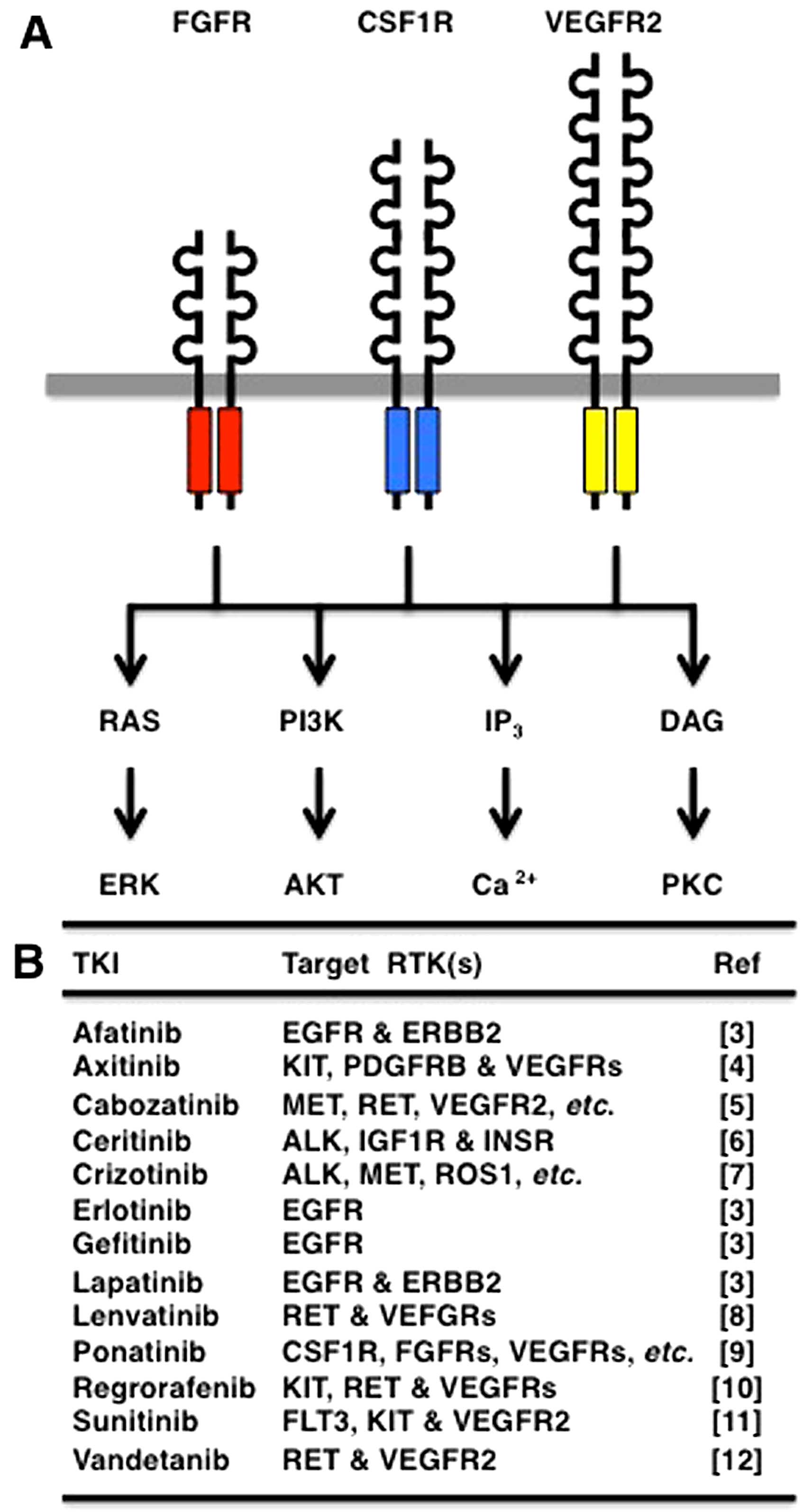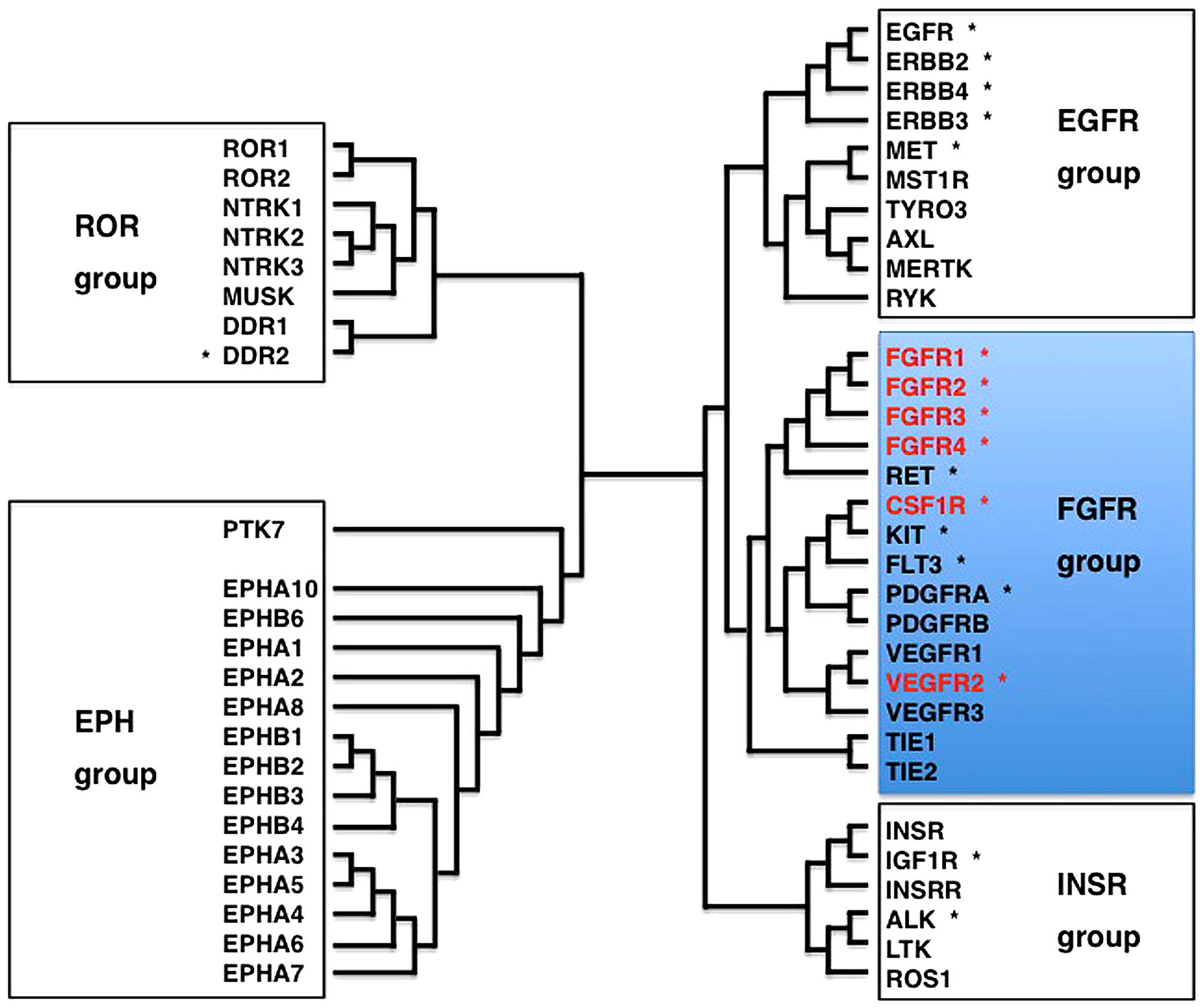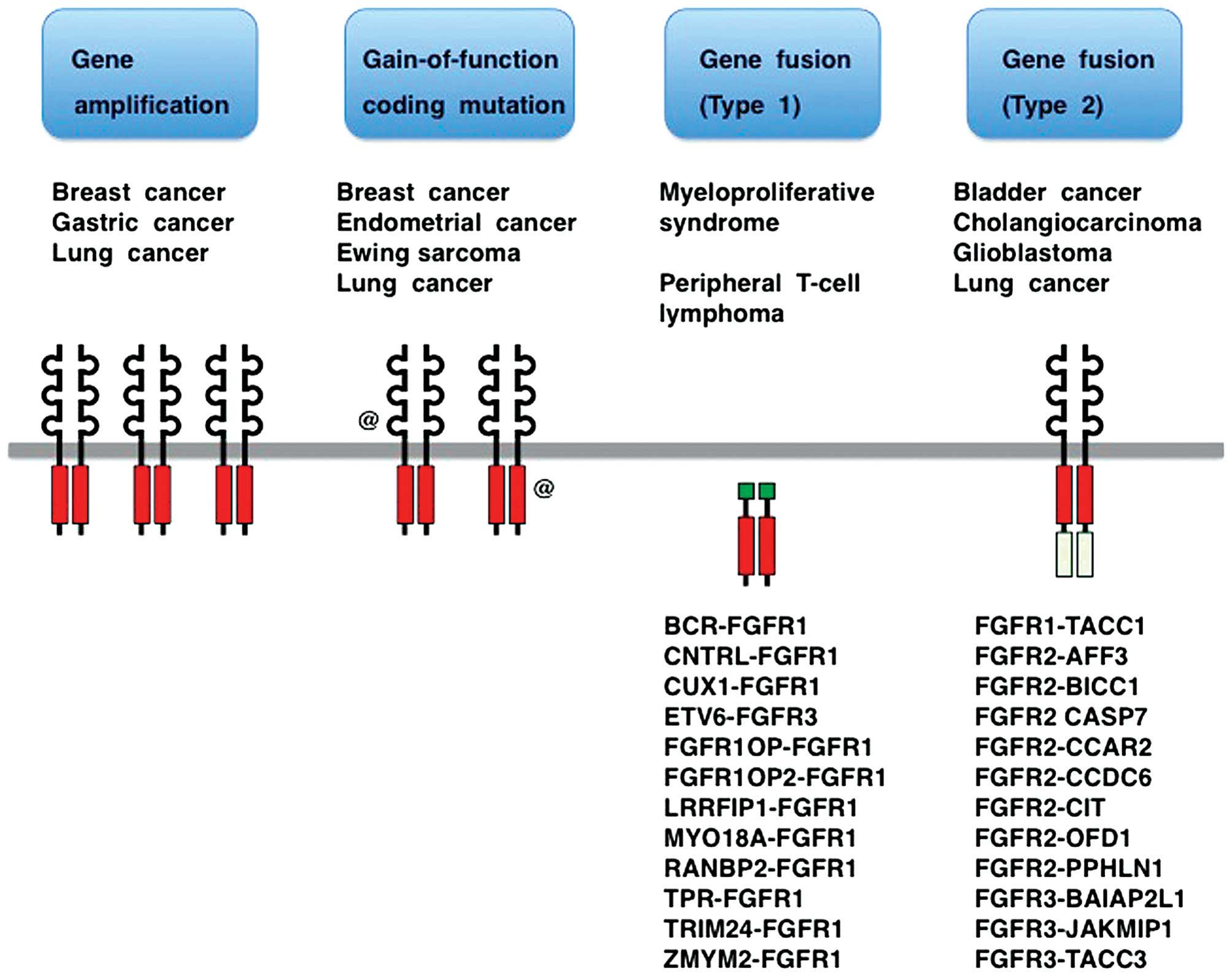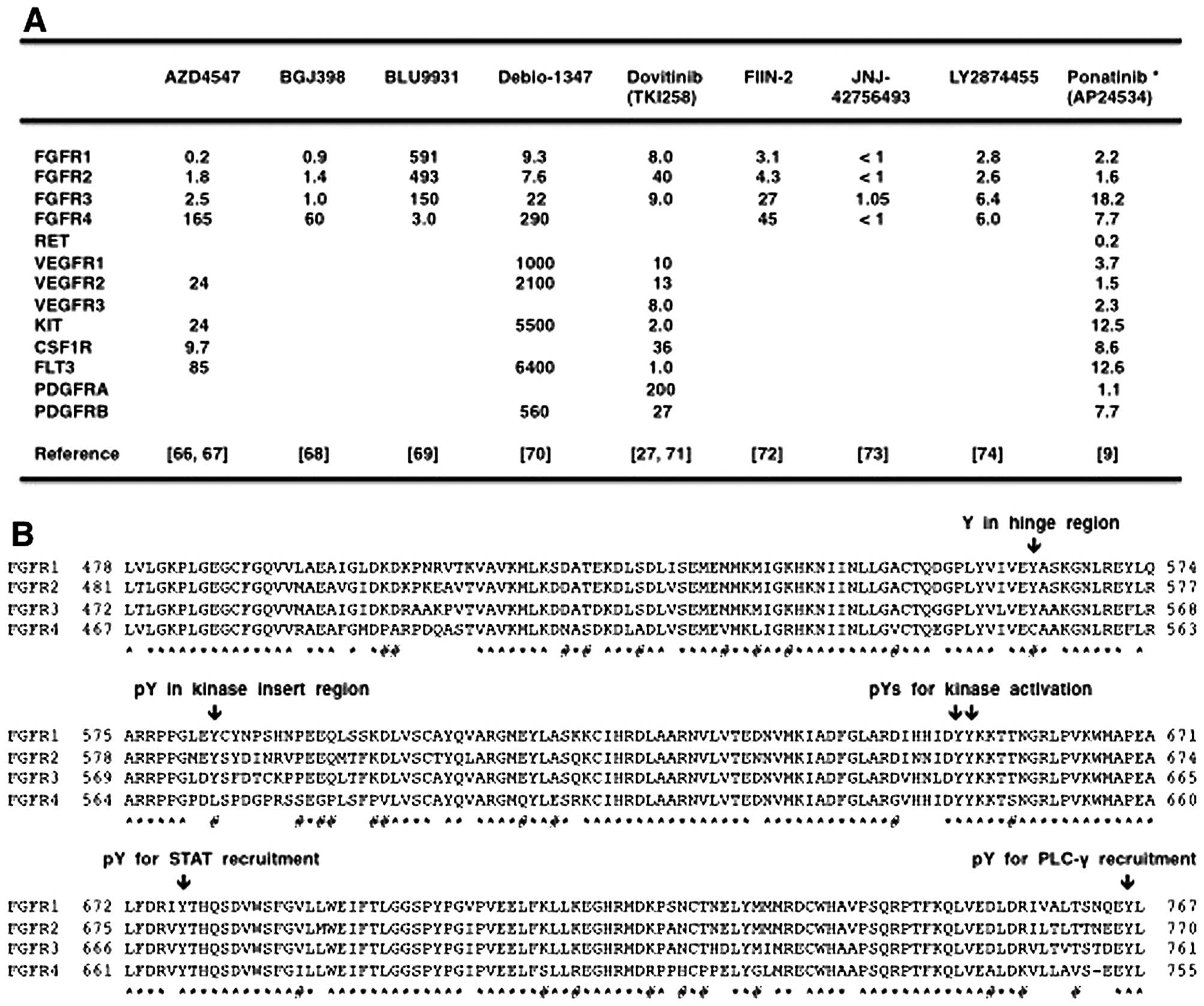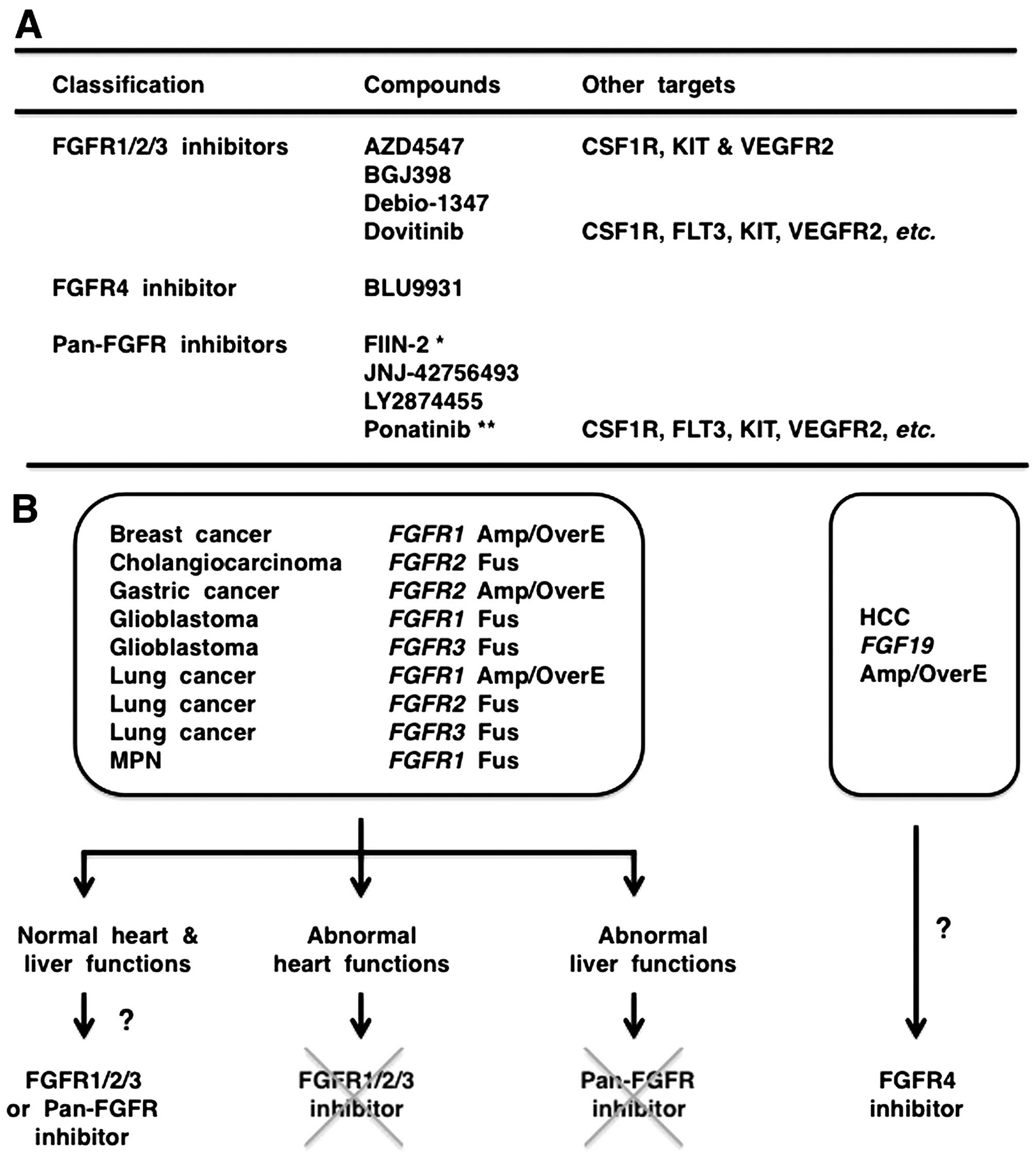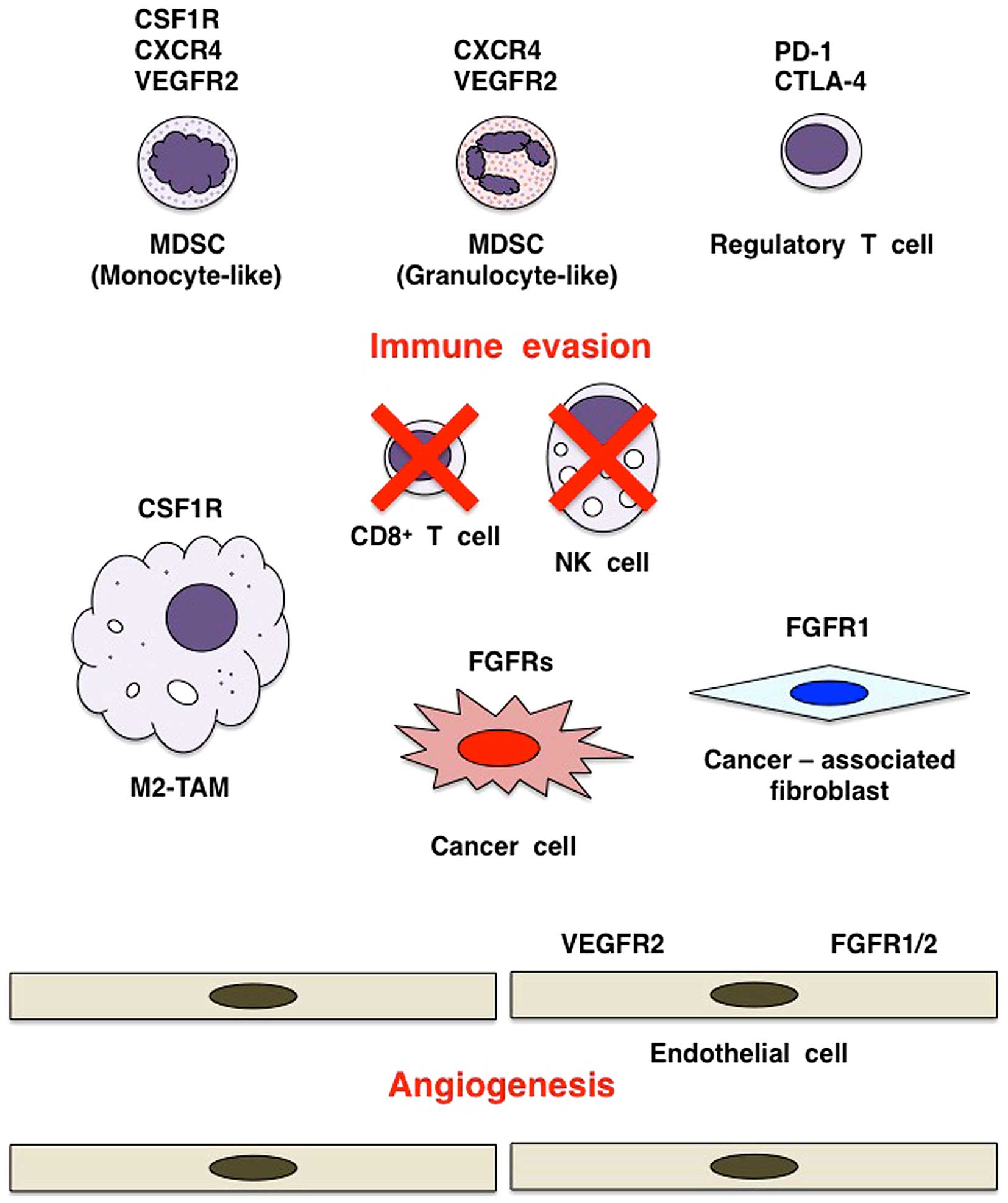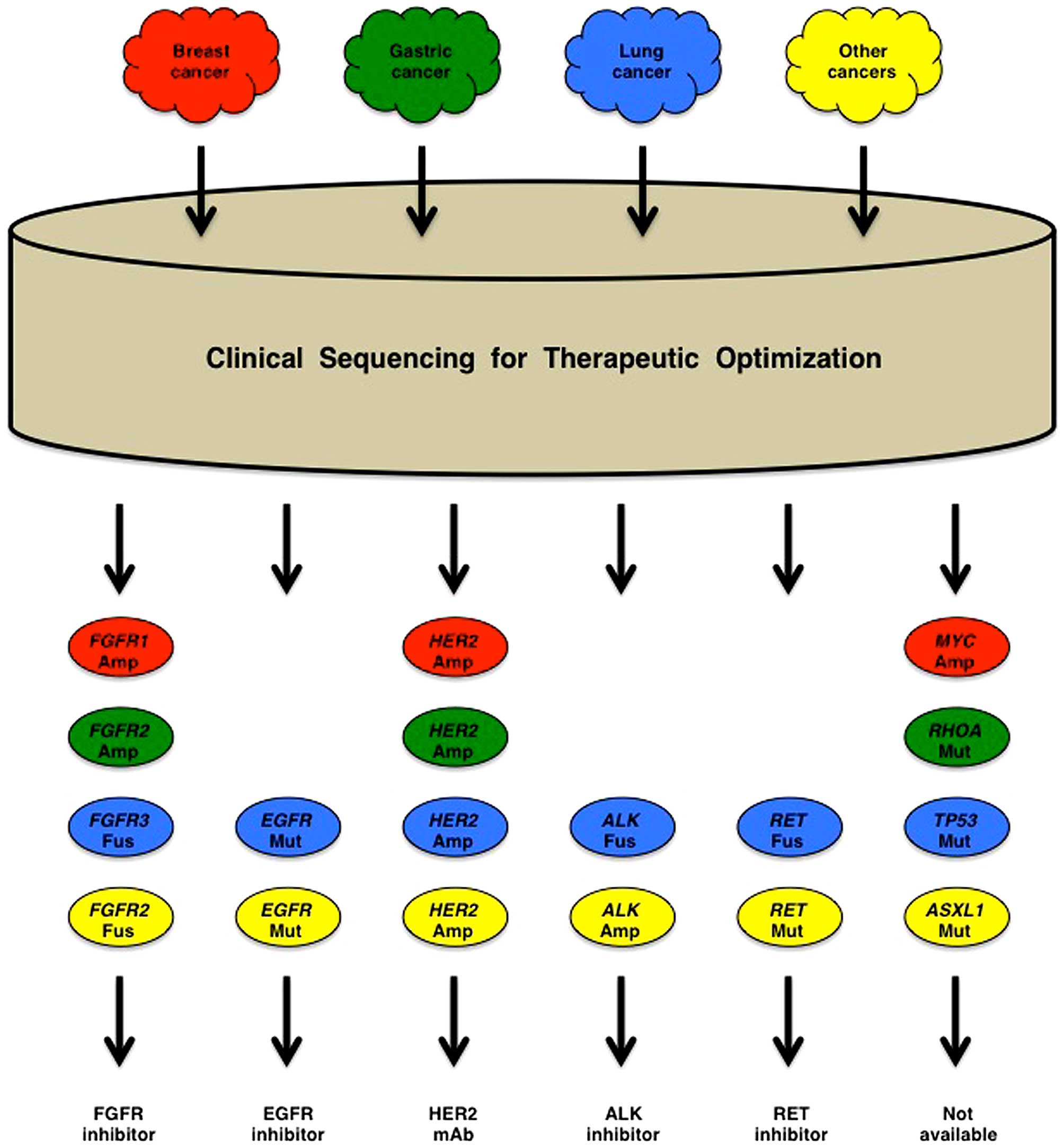|
1
|
Lemmon MA and Schlessinger J: Cell
signaling by receptor tyrosine kinases. Cell. 141:1117–1134. 2010.
View Article : Google Scholar : PubMed/NCBI
|
|
2
|
Manning G, Whyte DB, Martinez R, Hunter T
and Sudarsanam S: The protein kinase complement of the human
genome. Science. 298:1912–1934. 2002. View Article : Google Scholar : PubMed/NCBI
|
|
3
|
Roskoski R Jr: The ErbB/HER family of
protein-tyrosine kinases and cancer. Pharmacol Res. 79:34–74. 2014.
View Article : Google Scholar
|
|
4
|
Rugo HS, Herbst RS, Liu G, Park JW, Kies
MS, Steinfeldt HM, Pithavala YK, Reich SD, Freddo JL and Wilding G:
Phase I trial of the oral antiangiogenesis agent AG-013736 in
patients with advanced solid tumors: Pharmacokinetic and clinical
results. J Clin Oncol. 23:5474–5483. 2005. View Article : Google Scholar : PubMed/NCBI
|
|
5
|
Yakes FM, Chen J, Tan J, Yamaguchi K, Shi
Y, Yu P, Qian F, Chu F, Bentzien F, Cancilla B, et al: Cabozantinib
(XL184), a novel MET and VEGFR2 inhibitor, simultaneously
suppresses metastasis, angiogenesis, and tumor growth. Mol Cancer
Ther. 10:2298–2308. 2011. View Article : Google Scholar : PubMed/NCBI
|
|
6
|
Marsilje TH, Pei W, Chen B, Lu W, Uno T,
Jin Y, Jiang T, Kim S, Li N, Warmuth M, et al: Synthesis,
structure-activity relationships, and in vivo efficacy of the novel
potent and selective anaplastic lymphoma kinase (ALK) inhibitor
5-chloro-N2-(2-isopropoxy-5-methyl-4-(piperidin-4-yl)phenyl)-N4-(2-(isopropylsulfonyl)phenyl)
pyrimidine-2,4-diamine (LDK378) currently in phase 1 and phase 2
clinical trials. J Med Chem. 56:5675–5690. 2013. View Article : Google Scholar : PubMed/NCBI
|
|
7
|
Cui JJ, Tran-Dubé M, Shen H, Nambu M, Kung
PP, Pairish M, Jia L, Meng J, Funk L, Botrous I, et al: Structure
based drug design of crizotinib (PF-02341066), a potent and
selective dual inhibitor of mesenchymal-epithelial transition
factor (c-MET) kinase and anaplastic lymphoma kinase (ALK). J Med
Chem. 54:6342–6363. 2011. View Article : Google Scholar : PubMed/NCBI
|
|
8
|
Tohyama O, Matsui J, Kodama K, Hata-Sugi
N, Kimura T, Okamoto K, Minoshima Y, Iwata M and Funahashi Y:
Antitumor activity of lenvatinib (e7080): An angiogenesis inhibitor
that targets multiple receptor tyrosine kinases in preclinical
human thyroid cancer models. J Thyroid Res. 2014:6387472014.
View Article : Google Scholar : PubMed/NCBI
|
|
9
|
O'Hare T, Shakespeare WC, Zhu X, Eide CA,
Rivera VM, Wang F, Adrian LT, Zhou T, Huang WS, Xu Q, et al:
AP24534, a pan-BCR-ABL inhibitor for chronic myeloid leukemia,
potently inhibits the T315I mutant and overcomes mutation-based
resistance. Cancer Cell. 16:401–412. 2009. View Article : Google Scholar : PubMed/NCBI
|
|
10
|
Wilhelm SM, Dumas J, Adnane L, Lynch M,
Carter CA, Schütz G, Thierauch KH and Zopf D: Regorafenib (BAY
73-4506): A new oral multikinase inhibitor of angiogenic, stromal
and oncogenic receptor tyrosine kinases with potent preclinical
antitumor activity. Int J Cancer. 129:245–255. 2011. View Article : Google Scholar
|
|
11
|
Chow LQ and Eckhardt SG: Sunitinib: From
rational design to clinical efficacy. J Clin Oncol. 25:884–896.
2007. View Article : Google Scholar : PubMed/NCBI
|
|
12
|
Wells SA Jr, Gosnell JE, Gagel RF, Moley
J, Pfister D, Sosa JA, Skinner M, Krebs A, Vasselli J and
Schlumberger M: Vandetanib for the treatment of patients with
locally advanced or metastatic hereditary medullary thyroid cancer.
J Clin Oncol. 28:767–772. 2010. View Article : Google Scholar : PubMed/NCBI
|
|
13
|
Eswarakumar VP, Lax I and Schlessinger J:
Cellular signaling by fibroblast growth factor receptors. Cytokine
Growth Factor Rev. 16:139–149. 2005. View Article : Google Scholar : PubMed/NCBI
|
|
14
|
Katoh M and Nakagama H: FGF receptors:
Cancer biology and therapeutics. Med Res Rev. 34:280–300. 2014.
View Article : Google Scholar
|
|
15
|
Coleman SJ, Bruce C, Chioni AM, Kocher HM
and Grose RP: The ins and outs of fibroblast growth factor receptor
signalling. Clin Sci (Lond). 127:217–231. 2014. View Article : Google Scholar
|
|
16
|
Ornitz DM and Itoh N: The fibroblast
growth factor signaling pathway. Wiley Interdiscip Rev Dev Biol.
4:215–266. 2015. View Article : Google Scholar : PubMed/NCBI
|
|
17
|
Katoh M: FGFR2 abnormalities underlie a
spectrum of bone, skin, and cancer pathologies. J Invest Dermatol.
129:1861–1867. 2009. View Article : Google Scholar : PubMed/NCBI
|
|
18
|
Turner N and Grose R: Fibroblast growth
factor signalling: From development to cancer. Nat Rev Cancer.
10:116–129. 2010. View Article : Google Scholar : PubMed/NCBI
|
|
19
|
Kelleher FC, O'Sullivan H, Smyth E,
McDermott R and Viterbo A: Fibroblast growth factor receptors,
developmental corruption and malignant disease. Carcinogenesis.
34:2198–2205. 2013. View Article : Google Scholar : PubMed/NCBI
|
|
20
|
Helsten T, Schwaederle M and Kurzrock R:
Fibroblast growth factor receptor signaling in hereditary and
neoplastic disease: Biologic and clinical implications. Cancer
Metastasis Rev. 34:479–496. 2015. View Article : Google Scholar : PubMed/NCBI
|
|
21
|
Brooks AN, Kilgour E and Smith PD:
Molecular pathways: fibroblast growth factor signaling: a new
therapeutic opportunity in cancer. Clin Cancer Res. 18:1855–1862.
2012. View Article : Google Scholar : PubMed/NCBI
|
|
22
|
Chang J, Liu X, Wang S, Zhang Z, Wu Z,
Zhang X and Li J: Prognostic value of FGFR gene amplification in
patients with different types of cancer: A systematic review and
meta-analysis. PLoS One. 9:e1055242014. View Article : Google Scholar : PubMed/NCBI
|
|
23
|
Parker BC and Zhang W: Fusion genes in
solid tumors: An emerging target for cancer diagnosis and
treatment. Chin J Cancer. 32:594–603. 2013. View Article : Google Scholar : PubMed/NCBI
|
|
24
|
Feng S, Zhou L, Nice EC and Huang C:
Fibroblast growth factor receptors: Multifactorial-contributors to
tumor initiation and progression. Histol Histopathol. 30:13–31.
2015.
|
|
25
|
Liang G, Chen G, Wei X, Zhao Y and Li X:
Small molecule inhibition of fibroblast growth factor receptors in
cancer. Cytokine Growth Factor Rev. 24:467–475. 2013. View Article : Google Scholar : PubMed/NCBI
|
|
26
|
André F and Cortés J: Rationale for
targeting fibroblast growth factor receptor signaling in breast
cancer. Breast Cancer Res Treat. 150:1–8. 2015. View Article : Google Scholar : PubMed/NCBI
|
|
27
|
Porta C, Giglione P, Liguigli W and
Paglino C: Dovitinib (CHIR258, TKI258): Structure, development and
preclinical and clinical activity. Future Oncol. 11:39–50. 2015.
View Article : Google Scholar : PubMed/NCBI
|
|
28
|
Carter EP, Fearon AE and Grose RP:
Careless talk costs lives: Fibroblast growth factor receptor
signalling and the consequences of pathway malfunction. Trends Cell
Biol. 25:221–233. 2015. View Article : Google Scholar
|
|
29
|
Chang J, Wang S, Zhang Z, Liu X, Wu Z,
Geng R, Ge X, Dai C, Liu R, Zhang Q, et al: Multiple receptor
tyrosine kinase activation attenuates therapeutic efficacy of the
fibroblast growth factor receptor 2 inhibitor AZD4547 in FGFR2
amplified gastric cancer. Oncotarget. 6:2009–2022. 2015. View Article : Google Scholar : PubMed/NCBI
|
|
30
|
Wang J, Mikse O, Liao RG, Li Y, Tan L,
Janne PA, Gray NS, Wong KK and Hammerman PS: Ligand-associated
ERBB2/3 activation confers acquired resistance to FGFR inhibition
in FGFR3-dependent cancer cells. Oncogene. 34:2167–2177. 2015.
View Article : Google Scholar
|
|
31
|
Ronca R, Giacomini A, Rusnati M and Presta
M: The potential of fibroblast growth factor/fibroblast growth
factor receptor signaling as a therapeutic target in tumor
angiogenesis. Expert. Opin Ther Targets. 19:1361–1377. 2015.
View Article : Google Scholar
|
|
32
|
Salazar L, Kashiwada T, Krejci P, Meyer
AN, Casale M, Hallowell M, Wilcox WR, Donoghue DJ and Thompson LM:
Fibroblast growth factor receptor 3 interacts with and activates
TGFβ-activated kinase 1 tyrosine phosphorylation and NFκB signaling
in multiple myeloma and bladder cancer. PLoS One. 9:e864702014.
View Article : Google Scholar
|
|
33
|
Torre LA, Bray F, Siegel RL, Ferlay J,
Lortet-Tieulent J and Jemal A: Global cancer statistics, 2012. CA
Cancer J Clin. 65:87–108. 2015. View Article : Google Scholar : PubMed/NCBI
|
|
34
|
Weiss J, Sos ML, Seidel D, Peifer M,
Zander T, Heuckmann JM, Ullrich RT, Menon R, Maier S, Soltermann A,
et al: Frequent and focal FGFR1 amplification associates with
therapeutically tractable FGFR1 dependency in squamous cell lung
cancer. Sci Transl Med. 2:62ra932010. View Article : Google Scholar : PubMed/NCBI
|
|
35
|
Cihoric N, Savic S, Schneider S, Ackermann
I, Bichsel-Naef M, Schmid RA, Lardinois D, Gugger M, Bubendorf L,
Zlobec I, et al: Prognostic role of FGFR1 amplification in
early-stage non-small cell lung cancer. Br J Cancer. 110:2914–2922.
2014. View Article : Google Scholar : PubMed/NCBI
|
|
36
|
Preusser M, Berghoff AS, Berger W,
Ilhan-Mutlu A, Dinhof C, Widhalm G, Dieckmann K, Wöhrer A, Hackl M,
von Deimling A, et al: High rate of FGFR1 amplifications in brain
metastases of squamous and non-squamous lung cancer. Lung Cancer.
83:83–89. 2014. View Article : Google Scholar
|
|
37
|
Seo JS, Ju YS, Lee WC, Shin JY, Lee JK,
Bleazard T, Lee J, Jung YJ, Kim JO, Shin JY, et al: The
transcriptional landscape and mutational profile of lung
adenocarcinoma. Genome Res. 22:2109–2119. 2012. View Article : Google Scholar : PubMed/NCBI
|
|
38
|
Wu YM, Su F, Kalyana-Sundaram S, Khazanov
N, Ateeq B, Cao X, Lonigro RJ, Vats P, Wang R, Lin SF, et al:
Identification of targetable FGFR gene fusions in diverse cancers.
Cancer Discov. 3:636–647. 2013. View Article : Google Scholar : PubMed/NCBI
|
|
39
|
Tanizaki J, Ercan D, Capelletti M, Dodge
M, Xu C, Bahcall M, Tricker EM, Butaney M, Calles A, Sholl LM, et
al: Identification of oncogenic and drug-sensitizing mutations in
the extracellular domain of FGFR2. Cancer Res. 75:3139–3146. 2015.
View Article : Google Scholar : PubMed/NCBI
|
|
40
|
Maxmen A: The hard facts. Nature.
485:S50–S51. 2012. View Article : Google Scholar : PubMed/NCBI
|
|
41
|
Ellis MJ and Perou CM: The genomic
landscape of breast cancer as a therapeutic roadmap. Cancer Discov.
3:27–34. 2013. View Article : Google Scholar : PubMed/NCBI
|
|
42
|
Khoo BL, Lee SC, Kumar P, Tan TZ, Warkiani
ME, Ow SG, Nandi S, Lim CT and Thiery JP: Short-term expansion of
breast circulating cancer cells predicts response to anti-cancer
therapy. Oncotarget. 6:15578–15593. 2015. View Article : Google Scholar : PubMed/NCBI
|
|
43
|
Yu M, Bardia A, Aceto N, Bersani F, Madden
MW, Donaldson MC, Desai R, Zhu H, Comaills V, Zheng Z, et al:
Cancer therapy. Ex vivo culture of circulating breast tumor cells
for individualized testing of drug susceptibility. Science.
345:216–220. 2014. View Article : Google Scholar : PubMed/NCBI
|
|
44
|
André F, Bachelot T, Commo F, Campone M,
Arnedos M, Dieras V, Lacroix-Triki M, Lacroix L, Cohen P, Gentien
D, et al: Comparative genomic hybridisation array and DNA
sequencing to direct treatment of metastatic breast cancer: A
multicentre, prospective trial (SAFIR01/UNICANCER). Lancet Oncol.
15:267–274. 2014. View Article : Google Scholar : PubMed/NCBI
|
|
45
|
Turner N, Pearson A, Sharpe R, Lambros M,
Geyer F, Lopez-Garcia MA, Natrajan R, Marchio C, Iorns E, Mackay A,
et al: FGFR1 amplification drives endocrine therapy resistance and
is a therapeutic target in breast cancer. Cancer Res. 70:2085–2094.
2010. View Article : Google Scholar : PubMed/NCBI
|
|
46
|
Ferro A, Peleteiro B, Malvezzi M, Bosetti
C, Bertuccio P, Levi F, Negri E, La Vecchia C and Lunet N:
Worldwide trends in gastric cancer mortality 1980–2011 with
predictions to 2015, and incidence by subtype. Eur J Cancer.
50:1330–1344. 2014. View Article : Google Scholar : PubMed/NCBI
|
|
47
|
Holbrook JD, Parker JS, Gallagher KT,
Halsey WS, Hughes AM, Weigman VJ, Lebowitz PF and Kumar R: Deep
sequencing of gastric carcinoma reveals somatic mutations relevant
to personalized medicine. J Transl Med. 9:1192011. View Article : Google Scholar : PubMed/NCBI
|
|
48
|
Deng N, Goh LK, Wang H, Das K, Tao J, Tan
IB, Zhang S, Lee M, Wu J, Lim KH, et al: A comprehensive survey of
genomic alterations in gastric cancer reveals systematic patterns
of molecular exclusivity and co-occurrence among distinct
therapeutic targets. Gut. 61:673–684. 2012. View Article : Google Scholar : PubMed/NCBI
|
|
49
|
Jung EJ, Jung EJ, Min SY, Kim MA and Kim
WH: Fibroblast growth factor receptor 2 gene amplification status
and its clinicopathologic significance in gastric carcinoma. Hum
Pathol. 43:1559–1566. 2012. View Article : Google Scholar : PubMed/NCBI
|
|
50
|
Su X, Zhan P, Gavine PR, Morgan S, Womack
C, Ni X, Shen D, Bang YJ, Im SA, Ho Kim W, et al: FGFR2
amplification has prognostic significance in gastric cancer:
Results from a large international multicentre study. Br J Cancer.
110:967–975. 2014. View Article : Google Scholar : PubMed/NCBI
|
|
51
|
Xie L, Su X, Zhang L, Yin X, Tang L, Zhang
X, Xu Y, Gao Z, Liu K, Zhou M, et al: FGFR2 gene amplification in
gastric cancer predicts sensitivity to the selective FGFR inhibitor
AZD4547. Clin Cancer Res. 19:2572–2583. 2013. View Article : Google Scholar : PubMed/NCBI
|
|
52
|
Zhang T, Zhang L, Fan S, Zhang M, Fu H,
Liu Y, Yin X, Chen H, Xie L, Zhang J, et al: Patient-derived
gastric carcinoma xenograft mouse models faithfully represent human
tumor molecular diversity. PLoS One. 10:e01344932015. View Article : Google Scholar : PubMed/NCBI
|
|
53
|
Agelopoulos K, Richter GH, Schmidt E,
Dirksen U, von Heyking K, Moser B, Klein HU, Kontny U, Dugas M,
Poos K, et al: Deep sequencing in conjunction with expression and
functional analyses reveals activation of FGFR1 in Ewing sarcoma.
Clin Cancer Res. 21:4935–4946. 2015. View Article : Google Scholar : PubMed/NCBI
|
|
54
|
Reintjes N, Li Y, Becker A, Rohmann E,
Schmutzler R and Wollnik B: Activating somatic FGFR2 mutations in
breast cancer. PLoS One. 8:e602642013. View Article : Google Scholar : PubMed/NCBI
|
|
55
|
Byron SA, Gartside M, Powell MA, Wellens
CL, Gao F, Mutch DG, Goodfellow PJ and Pollock PM: FGFR2 point
mutations in 466 endometrioid endometrial tumors: Relationship with
MSI, KRAS, PIK3CA, CTNNB1 mutations and clinicopathological
features. PLoS One. 7:e308012012. View Article : Google Scholar : PubMed/NCBI
|
|
56
|
Ross JS, Wang K, Al-Rohil RN, Nazeer T,
Sheehan CE, Otto GA, He J, Palmer G, Yelensky R, Lipson D, et al:
Advanced urothelial carcinoma: Next-generation sequencing reveals
diverse genomic alterations and targets of therapy. Mod Pathol.
27:271–280. 2014. View Article : Google Scholar
|
|
57
|
Gartside MG, Chen H, Ibrahimi OA, Byron
SA, Curtis AV, Wellens CL, Bengston A, Yudt LM, Eliseenkova AV, Ma
J, et al: Loss-of-function fibroblast growth factor receptor-2
mutations in melanoma. Mol Cancer Res. 7:41–54. 2009. View Article : Google Scholar : PubMed/NCBI
|
|
58
|
Koika V, Varnavas P, Valavani H, Sidis Y,
Plummer L, Dwyer A, Quinton R, Kanaka-Gantenbein C, Pitteloud N,
Sertedaki A, et al: Comparative functional analysis of two
fibroblast growth factor receptor 1 (FGFR1) mutations affecting the
same residue (R254W and R254Q) in isolated hypogonadotropic
hypogonadism (IHH). Gene. 516:146–151. 2013. View Article : Google Scholar : PubMed/NCBI
|
|
59
|
Villanueva C, Jacobson-Dickman E, Xu C,
Manouvrier S, Dwyer AA, Sykiotis GP, Beenken A, Liu Y, Tommiska J,
Hu Y, et al: Congenital hypogonadotropic hypogonadism with split
hand/foot malformation: A clinical entity with a high frequency of
FGFR1 mutations. Genet Med. 17:651–659. 2015. View Article : Google Scholar :
|
|
60
|
Jackson CC, Medeiros LJ and Miranda RN:
8p11 myeloproliferative syndrome: A review. Hum Pathol. 41:461–476.
2010. View Article : Google Scholar : PubMed/NCBI
|
|
61
|
Kumar KR, Chen W, Koduru PR and Luu HS:
Myeloid and lymphoid neoplasm with abnormalities of FGFR1
presenting with trilineage blasts and RUNX1 rearrangement: A case
report and review of literature. Am J Clin Pathol. 143:738–748.
2015. View Article : Google Scholar : PubMed/NCBI
|
|
62
|
Yagasaki F, Wakao D, Yokoyama Y, Uchida Y,
Murohashi I, Kayano H, Taniwaki M, Matsuda A and Bessho M: Fusion
of ETV6 to fibroblast growth factor receptor 3 in peripheral T-cell
lymphoma with a t(4;12)(p16;p13) chromosomal translocation. Cancer
Res. 61:8371–8374. 2001.PubMed/NCBI
|
|
63
|
Ren M, Qin H, Kitamura E and Cowell JK:
Dysregulated signaling pathways in the development of
CNTRL-FGFR1-induced myeloid and lymphoid malignancies associated
with FGFR1 in human and mouse models. Blood. 122:1007–1016. 2013.
View Article : Google Scholar : PubMed/NCBI
|
|
64
|
Zhang J, Wu G, Miller CP, Tatevossian RG,
Dalton JD, Tang B, Orisme W, Punchihewa C, Parker M, Qaddoumi I, et
al: St Jude Children's Research Hospital-Washington University
Pediatric Cancer Genome Project: Whole-genome sequencing identifies
genetic alterations in pediatric low-grade gliomas. Nat Genet.
45:602–612. 2013. View Article : Google Scholar : PubMed/NCBI
|
|
65
|
Sia D, Losic B, Moeini A, Cabellos L, Hao
K, Revill K, Bonal D, Miltiadous O, Zhang Z, Hoshida Y, et al:
Massive parallel sequencing uncovers actionable FGFR2-PPHLN1 fusion
and ARAF mutations in intrahepatic cholangiocarcinoma. Nat Commun.
6:60872015. View Article : Google Scholar : PubMed/NCBI
|
|
66
|
Gavine PR, Mooney L, Kilgour E, Thomas AP,
Al-Kadhimi K, Beck S, Rooney C, Coleman T, Baker D, Mellor MJ, et
al: AZD4547: An orally bioavailable, potent, and selective
inhibitor of the fibroblast growth factor receptor tyrosine kinase
family. Cancer Res. 72:2045–2056. 2012. View Article : Google Scholar : PubMed/NCBI
|
|
67
|
Kwak Y, Cho H, Hur W and Sim T: Antitumor
effects and mechanisms of AZD4547 on FGFR2-deregulated endometrial
cancer cells. Mol Cancer Ther. 14:2292–2302. 2015. View Article : Google Scholar : PubMed/NCBI
|
|
68
|
Guagnano V, Kauffmann A, Wöhrle S, Stamm
C, Ito M, Barys L, Pornon A, Yao Y, Li F, Zhang Y, et al: FGFR
genetic alterations predict for sensitivity to NVP-BGJ398, a
selective pan-FGFR inhibitor. Cancer Discov. 2:1118–1133. 2012.
View Article : Google Scholar : PubMed/NCBI
|
|
69
|
Hagel M, Miduturu C, Sheets M, Rubin N,
Weng W, Stransky N, Bifulco N, Kim JL, Hodous B, Brooijmans N, et
al: First selective small molecule inhibitor of FGFR4 for the
treatment of hepatocellular carcinomas with an activated FGFR4
signaling pathway. Cancer Discov. 5:424–437. 2015. View Article : Google Scholar : PubMed/NCBI
|
|
70
|
Nakanishi Y, Akiyama N, Tsukaguchi T,
Fujii T, Sakata K, Sase H, Isobe T, Morikami K, Shindoh H, Mio T,
et al: The fibroblast growth factor receptor genetic status as a
potential predictor of the sensitivity to CH5183284/Debio 1347, a
novel selective FGFR inhibitor. Mol Cancer Ther. 13:2547–2558.
2014. View Article : Google Scholar : PubMed/NCBI
|
|
71
|
Lee SH, Lopes de Menezes D, Vora J, Harris
A, Ye H, Nordahl L, Garrett E, Samara E, Aukerman SL, Gelb AB, et
al: In vivo target modulation and biological activity of CHIR-258,
a multitargeted growth factor receptor kinase inhibitor, in colon
cancer models. Clin Cancer Res. 11:3633–3641. 2005. View Article : Google Scholar : PubMed/NCBI
|
|
72
|
Tan L, Wang J, Tanizaki J, Huang Z, Aref
AR, Rusan M, Zhu SJ, Zhang Y, Ercan D, Liao RG, et al: Development
of covalent inhibitors that can overcome resistance to
first-generation FGFR kinase inhibitors. Proc Natl Acad Sci USA.
111:E4869–E4877. 2014. View Article : Google Scholar : PubMed/NCBI
|
|
73
|
Tabernero J, Bahleda R, Dienstmann R,
Infante JR, Mita A, Italiano A, Calvo E, Moreno V, Adamo B, Gazzah
A, et al: Phase I dose-escalation study of JNJ-42756493, an oral
pan-fibroblast growth factor receptor inhibitor, in patients with
advanced solid tumors. J Clin Oncol. 33:3401–3408. 2015. View Article : Google Scholar : PubMed/NCBI
|
|
74
|
Zhao G, Li WY, Chen D, Henry JR, Li HY,
Chen Z, Zia-Ebrahimi M, Bloem L, Zhai Y, Huss K, et al: A novel,
selective inhibitor of fibroblast growth factor receptors that
shows a potent broad spectrum of antitumor activity in several
tumor xenograft models. Mol Cancer Ther. 10:2200–2210. 2011.
View Article : Google Scholar : PubMed/NCBI
|
|
75
|
Shah RR and Morganroth J: Update on
cardiovascular safety of tyrosine kinase inhibitors: With a special
focus on QT interval, left ventricular dysfunction and overall
risk/benefit. Drug Saf. 38:693–710. 2015. View Article : Google Scholar : PubMed/NCBI
|
|
76
|
Gacche RN and Meshram RJ: Angiogenic
factors as potential drug target: Efficacy and limitations of
anti-angiogenic therapy. Biochim Biophys Acta. 1846:161–179.
2014.PubMed/NCBI
|
|
77
|
Douxfils J, Haguet H, Mullier F, Chatelain
C, Graux C and Dogné JM: Association between BCR-ABL tyrosine
kinase inhibitors for chronic myeloid leukemia and cardiovascular
events, major molecular response, and overall survival: A
systematic review and meta-analysis. JAMA Oncol. Feb 4–2016.Epub
ahead of print. View Article : Google Scholar : PubMed/NCBI
|
|
78
|
Jain RK: Normalizing tumor
microenvironment to treat cancer: Bench to bedside to biomarkers. J
Clin Oncol. 31:2205–2218. 2013. View Article : Google Scholar : PubMed/NCBI
|
|
79
|
Quail DF and Joyce JA: Microenvironmental
regulation of tumor progression and metastasis. Nat Med.
19:1423–1437. 2013. View Article : Google Scholar : PubMed/NCBI
|
|
80
|
Junttila MR and de Sauvage FJ: Influence
of tumour micro-environment heterogeneity on therapeutic response.
Nature. 501:346–354. 2013. View Article : Google Scholar : PubMed/NCBI
|
|
81
|
Procopio MG, Laszlo C, Al Labban D, Kim
DE, Bordignon P, Jo SH, Goruppi S, Menietti E, Ostano P, Ala U, et
al: Combined CSL and p53 downregulation promotes cancer-associated
fibroblast activation. Nat Cell Biol. 17:1193–1204. 2015.
View Article : Google Scholar : PubMed/NCBI
|
|
82
|
Ware KE, Hinz TK, Kleczko E, Singleton KR,
Marek LA, Helfrich BA, Cummings CT, Graham DK, Astling D, Tan AC,
et al: A mechanism of resistance to gefitinib mediated by cellular
reprogramming and the acquisition of an FGF2-FGFR1 autocrine growth
loop. Oncogenesis. 2:e392013. View Article : Google Scholar : PubMed/NCBI
|
|
83
|
Suvannasankha A, Tompkins DR, Edwards DF,
Petyaykina KV, Crean CD, Fournier PG, Parker JM, Sandusky GE,
Ichikawa S, Imel EA, et al: FGF23 is elevated in multiple myeloma
and increases heparanase expression by tumor cells. Oncotarget.
6:19647–19660. 2015. View Article : Google Scholar : PubMed/NCBI
|
|
84
|
Weis SM and Cheresh DA: Tumor
angiogenesis: Molecular pathways and therapeutic targets. Nat Med.
17:1359–1370. 2011. View Article : Google Scholar : PubMed/NCBI
|
|
85
|
Bridges E, Oon CE and Harris A: Notch
regulation of tumor angiogenesis. Future Oncol. 7:569–588. 2011.
View Article : Google Scholar : PubMed/NCBI
|
|
86
|
Katoh M: Therapeutics targeting
angiogenesis: Genetics and epigenetics, extracellular miRNAs and
signaling networks (Review). Int J Mol Med. 32:763–767.
2013.PubMed/NCBI
|
|
87
|
Schmitt J and Matei D: Targeting
angiogenesis in ovarian cancer. Cancer Treat Rev. 38:272–283. 2012.
View Article : Google Scholar
|
|
88
|
Goel HL and Mercurio AM: VEGF targets the
tumour cell. Nat Rev Cancer. 13:871–882. 2013. View Article : Google Scholar : PubMed/NCBI
|
|
89
|
Oladipupo SS, Smith C, Santeford A, Park
C, Sene A, Wiley LA, Osei-Owusu P, Hsu J, Zapata N, Liu F, et al:
Endothelial cell FGF signaling is required for injury response but
not for vascular homeostasis. Proc Natl Acad Sci USA.
111:13379–13384. 2014. View Article : Google Scholar : PubMed/NCBI
|
|
90
|
Xiao L, Yang S, Hao J, Yuan X, Luo W,
Jiang L, Hu Y, Fu Z, Zhang Y and Zou C: Endostar attenuates
melanoma tumor growth via its interruption of b-FGF mediated
angiogenesis. Cancer Lett. 359:148–154. 2015. View Article : Google Scholar : PubMed/NCBI
|
|
91
|
Choi HJ, Armaiz Pena GN, Pradeep S, Cho
MS, Coleman RL and Sood AK: Anti-vascular therapies in ovarian
cancer: Moving beyond anti-VEGF approaches. Cancer Metastasis Rev.
34:19–40. 2015. View Article : Google Scholar :
|
|
92
|
Hilbert T and Klaschik S: The
angiopoietin/TIE receptor system: Focusing its role for
ischemia-reperfusion injury. Cytokine Growth Factor Rev.
26:281–291. 2015. View Article : Google Scholar
|
|
93
|
Fagiani E and Christofori G: Angiopoietins
in angiogenesis. Cancer Lett. 328:18–26. 2013. View Article : Google Scholar
|
|
94
|
Zhou W, Wang G and Guo S: Regulation of
angiogenesis via Notch signaling in breast cancer and cancer stem
cells. Biochim Biophys Acta. 1836:304–320. 2013.PubMed/NCBI
|
|
95
|
Rostama B, Peterson SM, Vary CP and Liaw
L: Notch signal integration in the vasculature during remodeling.
Vascul Pharmacol. 63:97–104. 2014. View Article : Google Scholar : PubMed/NCBI
|
|
96
|
Zhang P, Yan X, Chen Y, Yang Z and Han H:
Notch signaling in blood vessels: From morphogenesis to
homeostasis. Sci China Life Sci. 57:774–780. 2014. View Article : Google Scholar : PubMed/NCBI
|
|
97
|
Bertolini F, Marighetti P, Martin-Padura
I, Mancuso P, Hu-Lowe DD, Shaked Y and D'Onofrio A: Anti-VEGF and
beyond: Shaping a new generation of anti-angiogenic therapies for
cancer. Drug Discov Today. 16:1052–1060. 2011. View Article : Google Scholar : PubMed/NCBI
|
|
98
|
Schreiber RD, Old LJ and Smyth MJ: Cancer
immunoediting: Integrating immunity's roles in cancer suppression
and promotion. Science. 331:1565–1570. 2011. View Article : Google Scholar : PubMed/NCBI
|
|
99
|
Talmadge JE and Gabrilovich DI: History of
myeloid-derived suppressor cells. Nat Rev Cancer. 13:739–752. 2013.
View Article : Google Scholar : PubMed/NCBI
|
|
100
|
Mantovani A and Sica A: Macrophages,
innate immunity and cancer: Balance, tolerance, and diversity. Curr
Opin Immunol. 22:231–237. 2010. View Article : Google Scholar : PubMed/NCBI
|
|
101
|
Sakaguchi S, Miyara M, Costantino CM and
Hafler DA: FOXP3+ regulatory T cells in the human immune
system. Nat Rev Immunol. 10:490–500. 2010. View Article : Google Scholar : PubMed/NCBI
|
|
102
|
Balkwill FR: The chemokine system and
cancer. J Pathol. 226:148–157. 2012. View Article : Google Scholar
|
|
103
|
Lippitz BE: Cytokine patterns in patients
with cancer: A systematic review. Lancet Oncol. e218–e228. 2013.
View Article : Google Scholar : PubMed/NCBI
|
|
104
|
Condamine T, Ramachandran I, Youn JI and
Gabrilovich DI: Regulation of tumor metastasis by myeloid-derived
suppressor cells. Annu Rev Med. 66:97–110. 2015. View Article : Google Scholar :
|
|
105
|
Rivera LB and Bergers G: Intertwined
regulation of angiogenesis and immunity by myeloid cells. Trends
Immunol. 36:240–249. 2015. View Article : Google Scholar : PubMed/NCBI
|
|
106
|
Chen Y, Ramjiawan RR, Reiberger T, Ng MR,
Hato T, Huang Y, Ochiai H, Kitahara S, Unan EC, Reddy TP, et al:
CXCR4 inhibition in tumor microenvironment facilitates
anti-programmed death receptor-1 immunotherapy in sorafenib-treated
hepatocellular carcinoma in mice. Hepatology. 61:1591–1602. 2015.
View Article : Google Scholar :
|
|
107
|
Holdman XB, Welte T, Rajapakshe K, Pond A,
Coarfa C, Mo Q, Huang S, Hilsenbeck SG, Edwards DP, Zhang X, et al:
Upregulation of EGFR signaling is correlated with tumor stroma
remodeling and tumor recurrence in FGFR1-driven breast cancer.
Breast Cancer Res. 17:1412015. View Article : Google Scholar : PubMed/NCBI
|
|
108
|
Liu L, Ye TH, Han YP, Song H, Zhang YK,
Xia Y, Wang NY, Xiong Y, Song XJ, Zhu YX, et al: Reductions in
myeloid-derived suppressor cells and lung metastases using AZD4547
treatment of a metastatic murine breast tumor model. Cell Physiol
Biochem. 33:633–645. 2014. View Article : Google Scholar : PubMed/NCBI
|
|
109
|
Hume DA and MacDonald KP: Therapeutic
applications of macrophage colony-stimulating factor-1 (CSF-1) and
antagonists of CSF-1 receptor (CSF-1R) signaling. Blood.
119:1810–1820. 2012. View Article : Google Scholar
|
|
110
|
Sieweke MH and Allen JE: Beyond stem
cells: Self-renewal of differentiated macrophages. Science.
342:12429742013. View Article : Google Scholar : PubMed/NCBI
|
|
111
|
Hamilton JA and Achuthan A: Colony
stimulating factors and myeloid cell biology in health and disease.
Trends Immunol. 34:81–89. 2013. View Article : Google Scholar
|
|
112
|
Moughon DL, He H, Schokrpur S, Jiang ZK,
Yaqoob M, David J, Lin C, Iruela-Arispe ML, Dorigo O and Wu L:
Macrophage blockade using CSF1R inhibitors reverses the vascular
leakage underlying malignant ascites in late-stage epithelial
ovarian cancer. Cancer Res. 75:4742–4752. 2015. View Article : Google Scholar : PubMed/NCBI
|
|
113
|
DeNardo DG, Brennan DJ, Rexhepaj E,
Ruffell B, Shiao SL, Madden SF, Gallagher WM, Wadhwani N, Keil SD,
Junaid SA, et al: Leukocyte complexity predicts breast cancer
survival and functionally regulates response to chemotherapy.
Cancer Discov. 1:54–67. 2011. View Article : Google Scholar : PubMed/NCBI
|
|
114
|
Xu J, Escamilla J, Mok S, David J,
Priceman S, West B, Bollag G, McBride W and Wu L: CSF1R signaling
blockade stanches tumor-infiltrating myeloid cells and improves the
efficacy of radiotherapy in prostate cancer. Cancer Res.
73:2782–2794. 2013. View Article : Google Scholar : PubMed/NCBI
|
|
115
|
Ries CH, Cannarile MA, Hoves S, Benz J,
Wartha K, Runza V, Rey-Giraud F, Pradel LP, Feuerhake F, Klaman I,
et al: Targeting tumor-associated macrophages with anti-CSF-1R
antibody reveals a strategy for cancer therapy. Cancer Cell.
25:846–859. 2014. View Article : Google Scholar : PubMed/NCBI
|
|
116
|
Rivera LB, Meyronet D, Hervieu V,
Frederick MJ, Bergsland E and Bergers G: Intratumoral myeloid cells
regulate responsiveness and resistance to antiangiogenic therapy.
Cell Rep. 11:577–591. 2015. View Article : Google Scholar : PubMed/NCBI
|
|
117
|
Beenken A and Mohammadi M: The FGF family:
Biology, pathophysiology and therapy. Nat Rev Drug Discov.
8:235–253. 2009. View Article : Google Scholar : PubMed/NCBI
|
|
118
|
Degirolamo C, Sabbà C and Moschetta A:
Therapeutic potential of the endocrine fibroblast growth factors
FGF19, FGF21 and FGF23. Nat Rev Drug Discov. 15:51–69. 2016.
View Article : Google Scholar
|
|
119
|
Liu WY, Xie DM, Zhu GQ, Huang GQ, Lin YQ,
Wang LR, Shi KQ, Hu B, Braddock M, Chen YP, et al: Targeting
fibroblast growth factor 19 in liver disease: A potential biomarker
and therapeutic target. Expert. Opin Ther Targets. 19:675–685.
2015. View Article : Google Scholar
|
|
120
|
Pai R, French D, Ma N, Hotzel K, Plise E,
Salphati L, Setchell KD, Ware J, Lauriault V, Schutt L, et al:
Antibody-mediated inhibition of fibroblast growth factor 19 results
in increased bile acids synthesis and ileal malabsorption of bile
acids in cynomolgus monkeys. Toxicol Sci. 126:446–456. 2012.
View Article : Google Scholar : PubMed/NCBI
|
|
121
|
Ge H, Zhang J, Gong Y, Gupte J, Ye J,
Weiszmann J, Samayoa K, Coberly S, Gardner J, Wang H, et al:
Fibroblast growth factor receptor 4 (FGFR4) deficiency improves
insulin resistance and glucose metabolism under diet-induced
obesity conditions. J Biol Chem. 289:30470–30480. 2014. View Article : Google Scholar : PubMed/NCBI
|
|
122
|
Silswal N, Touchberry CD, Daniel DR,
McCarthy DL, Zhang S, Andresen J, Stubbs JR and Wacker MJ: FGF23
directly impairs endothelium-dependent vasorelaxation by increasing
superoxide levels and reducing nitric oxide bioavailability. Am J
Physiol Endocrinol Metab. 307:E426–E436. 2014. View Article : Google Scholar : PubMed/NCBI
|
|
123
|
Grabner A, Amaral AP, Schramm K, Singh S,
Sloan A, Yanucil C, Li J, Shehadeh LA, Hare JM, David V, et al:
Activation of cardiac fibroblast growth factor receptor 4 causes
left ventricular hypertrophy. Cell Metab. 22:1020–1032. 2015.
View Article : Google Scholar : PubMed/NCBI
|
|
124
|
Vogelstein B, Papadopoulos N, Velculescu
VE, Zhou S, Diaz LA Jr and Kinzler KW: Cancer genome landscapes.
Science. 339:1546–1558. 2013. View Article : Google Scholar : PubMed/NCBI
|
|
125
|
Wynes MW, Hinz TK, Gao D, Martini M, Marek
LA, Ware KE, Edwards MG, Böhm D, Perner S, Helfrich BA, et al:
FGFR1 mRNA and protein expression, not gene copy number, predict
FGFR TKI sensitivity across all lung cancer histologies. Clin
Cancer Res. 20:3299–3309. 2014. View Article : Google Scholar : PubMed/NCBI
|
|
126
|
Wöhrle S, Weiss A, Ito M, Kauffmann A,
Murakami M, Jagani Z, Thuery A, Bauer-Probst B, Reimann F, Stamm C,
et al: Fibroblast growth factor receptors as novel therapeutic
targets in SNF5-deleted malignant rhabdoid tumors. PLoS One.
8:e776522013. View Article : Google Scholar : PubMed/NCBI
|
|
127
|
Künstlinger H, Fassunke J, Schildhaus HU,
Brors B, Heydt C, Ihle MA, Mechtersheimer G, Wardelmann E, Büttner
R and Merkelbach-Bruse S: FGFR2 is overexpressed in myxoid
liposarcoma and inhibition of FGFR signaling impairs tumor growth
in vitro. Oncotarget. 6:20215–20230. 2015. View Article : Google Scholar : PubMed/NCBI
|
|
128
|
Zhang J, Fujimoto J, Zhang J, Wedge DC,
Song X, Zhang J, Seth S, Chow CW, Cao Y, Gumbs C, et al: Intratumor
heterogeneity in localized lung adenocarcinomas delineated by
multiregion sequencing. Science. 346:256–259. 2014. View Article : Google Scholar : PubMed/NCBI
|
|
129
|
Bertotti A, Papp E, Jones S, Adleff V,
Anagnostou V, Lupo B, Sausen M, Phallen J, Hruban CA, Tokheim C, et
al: The genomic landscape of response to EGFR blockade in
colorectal cancer. Nature. 526:263–267. 2015. View Article : Google Scholar : PubMed/NCBI
|
|
130
|
Crystal AS, Shaw AT, Sequist LV, Friboulet
L, Niederst MJ, Lockerman EL, Frias RL, Gainor JF, Amzallag A,
Greninger P, et al: Patient-derived models of acquired resistance
can identify effective drug combinations for cancer. Science.
346:1480–1486. 2014. View Article : Google Scholar : PubMed/NCBI
|
|
131
|
Chell V, Balmanno K, Little AS, Wilson M,
Andrews S, Blockley L, Hampson M, Gavine PR and Cook SJ: Tumour
cell responses to new fibroblast growth factor receptor tyrosine
kinase inhibitors and identification of a gatekeeper mutation in
FGFR3 as a mechanism of acquired resistance. Oncogene.
32:3059–3070. 2013. View Article : Google Scholar
|
|
132
|
Ang D, Ballard M, Beadling C, Warrick A,
Schilling A, O'Gara R, Pukay M, Neff TL, West RB, Corless CL, et
al: Novel mutations in neuroendocrine carcinoma of the breast:
Possible therapeutic targets. Appl Immunohistochem Mol Morphol.
23:97–103. 2015. View Article : Google Scholar : PubMed/NCBI
|
|
133
|
Okazaki T and Honjo T: PD-1 and PD-1
ligands: From discovery to clinical application. Int Immunol.
19:813–824. 2007. View Article : Google Scholar : PubMed/NCBI
|
|
134
|
Sharma P and Allison JP: The future of
immune checkpoint therapy. Science. 348:56–61. 2015. View Article : Google Scholar : PubMed/NCBI
|
|
135
|
Topalian SL, Drake CG and Pardoll DM:
Immune checkpoint blockade: A common denominator approach to cancer
therapy. Cancer Cell. 27:450–461. 2015. View Article : Google Scholar : PubMed/NCBI
|
|
136
|
Mahoney KM, Rennert PD and Freeman GJ:
Combination cancer immunotherapy and new immunomodulatory targets.
Nat Rev Drug Discov. 14:561–584. 2015. View Article : Google Scholar : PubMed/NCBI
|
|
137
|
Hovelson DH, McDaniel AS, Cani AK, Johnson
B, Rhodes K, Williams PD, Bandla S, Bien G, Choppa P, Hyland F, et
al: Development and validation of a scalable next-generation
sequencing.
|















